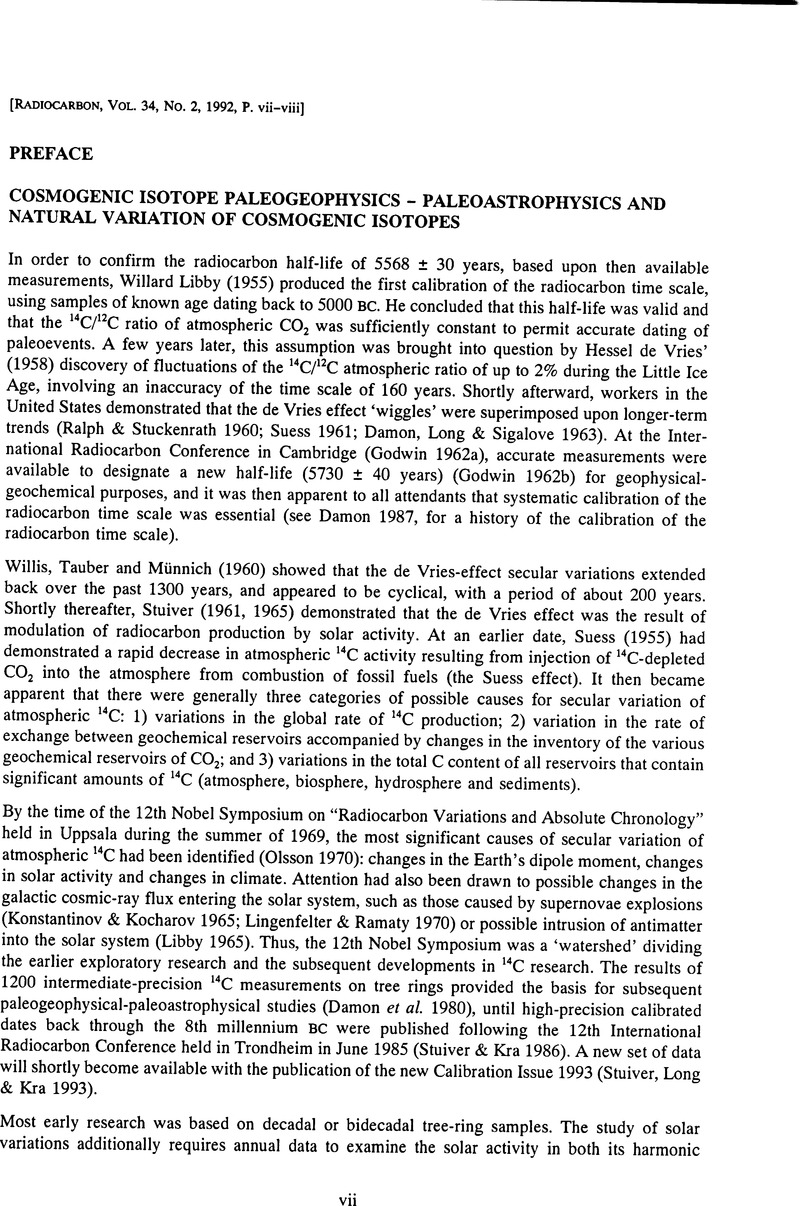No CrossRef data available.
Article contents
Cosmogenic Isotope Paleogeophysics - Paleoastrophysics and Natural Variation of Cosmogenic Isotopes
Published online by Cambridge University Press: 18 July 2016
Abstract
An abstract is not available for this content so a preview has been provided. As you have access to this content, a full PDF is available via the ‘Save PDF’ action button.

- Type
- Preface
- Information
- Copyright
- Copyright © The American Journal of Science
References
Cowan, C., Atluri, C. R. and Libby, W. F.
1965
Possible anti-matter content of the tunguska meteor of 1908. Nature
206: 861–865.Google Scholar
Damon, P. E.
1987
The history of the calibration of radiocarbon dates by dendrochronology. In Aurenche, O., Evin, J. and Hourst, F., eds., Relative Chronologies and Absolute Chronology 16,000-4,000 BP. BAR International Series 379: 61–104.Google Scholar
Damon, P. E., Lerman, J. C., Long, A., Bannister, B., Klein, J. and Linick, T. W.
1980
Report on the workshop on calibration of the radiocarbon time scale, In Stuiver, M. and Kra, R. S., eds., Proceedings of the 10th International 14C Conference. Radiocarbon
22(3): 947–949.Google Scholar
Damon, P. E., Long, A. and Sigalove, J. J.
1963
Arizona radiocarbon dates IV. Radiocarbon
5: 283-301.Google Scholar
de Vries, H.
1958
Variation in concentration of radiocarbon with time and location on earth. Koninklijke Nederlandse Akademie van Wetenschappen. Proceedings Series B 61: 94–102.Google Scholar
Konstantinov, B. P. and Kocharov, G. E.
1965
Astrophysical phenomena and radiocarbon. Doklady Akademii Nauk SSSR
165: 63-64.Google Scholar
Libby, W. F.
1955
Radiocarbon Dating. Second Edition. Chicago, University of Chicago Press: 175 p.Google Scholar
Lingenfelter, R. E. and Ramaty, R.
1970
Astrophysical and geophysical variations in 14C production. In Olsson, I., ed., Radiocarbon Variations and Absolute Chronology. Proceedings of the 12th Nobel Symposium. New York, John Wiley & Sons: 513–537.Google Scholar
Nesme-Ribes, E. and Mangeney, A.
1992
On a plausible physical mechanism linking the Maunder Minimum to the Little Ice Age. Radiocarbon, this issue.CrossRefGoogle Scholar
Olsson, I., ed. 1970
Radiocarbon Variations and Absolute Chronology. Proceedings of the 12th Nobel Symposium. New York, John Wiley & Sons: 652 p.Google Scholar
Pavlov, A. K., Kogan, V. T. and Gladkov, G. Y.
1992
A tandem mass-spectrometric method of cosmogenic isotope analysis. Radiocarbon, this issue.Google Scholar
Ralph, E. K. and Stuckenrath, R.
1960
Carbon-14 measurements of known age samples. Nature
188: 185-187.Google Scholar
Stuiver, M.
1961
Variations in radiocarbon concentration and sunspot activity. Journal of Geophysical Research
66: 273-276.Google Scholar
Stuiver, M.
1965
Carbon-14 content of 18th-and 19th-century wood, variations correlated with sunspot activity. Science
149: 533-535.Google Scholar
Stuiver, M. and Kra, R. S., eds. 1986
Calibration Issue. Proceedings of the 12th International Radiocarbon conference. Radiocarbon
28(2B): 1030 p.Google Scholar
Stuiver, M., Long, A. and Kra, R. S., eds. 1993
Calibration Issue 1993. Radiocarbon
35(1), in press.Google Scholar
Suess, H. E.
1961
Secular variations in the concentration of atmospheric radiocarbon. In Proceedings of a Conference on Problems Related to Interplanetary Matter. NAS-NRC Publication 845: 90–95.Google Scholar
Willis, E. H., Tauber, H. and Munnich, K. O.
1960
Variations in the atmospheric radiocarbon concentration over the past 1300 years. Radiocarbon
3: 1–4.Google Scholar


